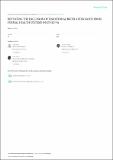Discussion Paper No. 003/2010 - Revisiting the Exclusion of Traditional Birth Attendants from Formal Health Systems in Ethiopia
View/
Publication Date
2010Type
Otherviews
downloads
Metadata
Show full item recordCitation
Yousuf, J., Mulatu, T., Nigatu, T., & Seyum, D. (2010). Revisiting the exclusion of traditional birth attendants from formal health systems in Ethiopia. Africa Medical and Reserch Foundation, 5(7-10).
Abstract/
Traditional birth attendants have been a subject of discussion in the provision of maternal and newborn health care, especially in developing countries where there is a lack of infrastructure and trained health personnel. The objective of this study was to assess the role of trained traditional birth attendants in maternal and newborn health care in Afar Regional State. A qualitative cross-sectional study was conducted and 22 in-depth interviews and 6 focus group discussions conducted with health service providers, trained traditional birth attendants, mothers, men, kebele leaders and district health personnel. The findings of this study indicate that trained traditional birth attendants are the backbone of the maternal and child health development in pastoralist communities. However, the current numbers are inadequate and cannot meet the needs of the pastoralist communities including antenatal care, delivery, postnatal care and family planning. The study found that 92% of women (of which 90% were attended to by TTBAs) in zone 3 of Afar delivered their last child at home. In addition to service delivery (65%), all respondents agreed on multiple contributions of TTBAs, which include counselling, child care, immunisation, postnatal care and other social services. Moreover, most respondents agreed that the TTBAs played an important role in early detection of complications and in linking mothers to the health facilities. Without deploying adequate number of trained health workers for delivery service, trained traditional birth attendants remain vital for the rural community in need of maternal and child health care service, especially in areas with poor infrastructure. With close supportive supervision and evaluation of the trainings, the TTBAs can greatly contribute to decreasing maternal and newborn mortality rates. Both the government and non-governmental organisations should provide the necessary recognition and supportive supervision since TTBAs enjoy community goodwill and will continue to provide services to rural communities in Ethiopia for a long time.
Subject/
Traditional birth attendants; Maternal and newborn; Afar; Maternal and child health; TBAs
Further Details
The publishers will gladly consider any request for permission to reproduce part or the whole of this publication with the intention of increasing its availability to those who need it. AMREF welcomes enquiries from individuals or organisations wishing to use the content for non-commercial purposes. The organisation would also be grateful to learn how you are using this publication, and welcomes constructive comments and suggestions.

